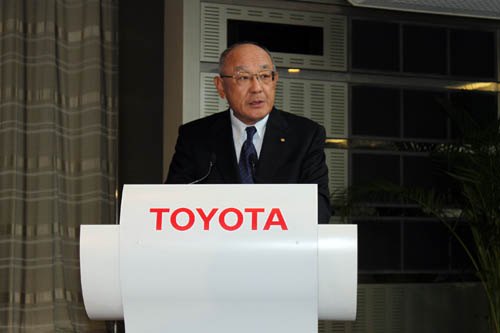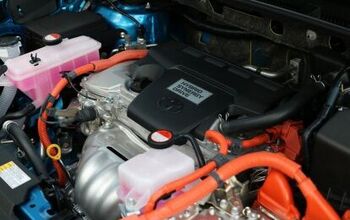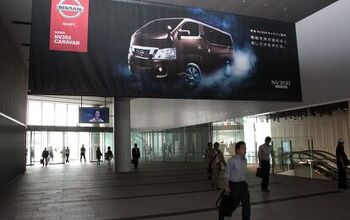Toyota Wants To Learn From Nissan

None of the approximately 100 journalists that packed Toyota’s basement meeting room in Tokyo today was surprised when the midterm results of the current fiscal year were announced, and there was an operating loss of 32.6 billion yen ($417 million). The loss was a little higher than expected, but expected it was. If you lose 689,000 units in sales, then you are bound to lose some money. The surprise came in the form of an unexpected new benchmark: Nissan.
Usually, no competitor is mentioned in public by name. Today, Toyota’s CFO Satoshi Ozawa named Nissan at least twice as an example worth following. Looking at the way Nissan handled the earthquake and the floods in Thailand, Ozawa said:
“It seems that Nissan has run their operations wiser than Toyota has done. If there is something we can learn from their example, then there is some homework for us to do.”
Five minutes later, Ozawa admires Nissan again:
“In terms of what happened after the earthquake or the Thai flooding, it seems Nissan suffered less than Toyota. If there is something there to learn from, we’d like to do that.”
Unsaid, but evident: There is a much bigger disaster which Nissan handles better than Toyota: The soaring yen. Toyota makes 3 million cars in Japan, and more than half of them are exported. Nissan also exports more than half of its Japanese production. However, this is down to a million units annually. Despite earthquake and yen, Nissan recorded an operating profit of 309.7 billion yen (US $3.88 billion) in the first six months of the fiscal, while Toyota lost money.
Nissan’s Ghosn had taken the lead in rallying against the “abnormal yen.” On Monday, Japan’s manufacturer association JAMA joined in. At a JAMA press conference, Akio Toyoda, who is also vice chairman JAMA, urged the government to immediately address the strong yen, and said the government “must do something to stop the manufacturing base from collapsing.”
Nevertheless, Toyota is sticking to the concept of making 3 million cars at home, literally at all costs. Complicated calisthenics are needed to maintain that level. Currently, 1.3 million cars are sold domestically, and 1.7 million are exported. In the future, the relationship is planned to go to 1.5 million sold at home and 1.5 shipped abroad. Toyota is looking to the Japanese government for a lower vehicle tax to crank up flagging domestic sales. Currently, most power trains are made in Japan and shipped abroad. “We will make more efforts to produce them outside of Japan,” Ozawa said.
For the second time this year, Toyota did not make a forecast for the rest of the year. The first time was after the March 11 tsunami. This time, Toyota is unable to fully quantify the effects of the Thai floods. As of the end of this week, the floods in Thailand will have cost 150,000 unproduced cars.

Bertel Schmitt comes back to journalism after taking a 35 year break in advertising and marketing. He ran and owned advertising agencies in Duesseldorf, Germany, and New York City. Volkswagen A.G. was Bertel's most important corporate account. Schmitt's advertising and marketing career touched many corners of the industry with a special focus on automotive products and services. Since 2004, he lives in Japan and China with his wife <a href="http://www.tomokoandbertel.com"> Tomoko </a>. Bertel Schmitt is a founding board member of the <a href="http://www.offshoresuperseries.com"> Offshore Super Series </a>, an American offshore powerboat racing organization. He is co-owner of the racing team Typhoon.
More by Bertel Schmitt
Latest Car Reviews
Read moreLatest Product Reviews
Read moreRecent Comments
- SCE to AUX All that lift makes for an easy rollover of your $70k truck.
- SCE to AUX My son cross-shopped the RAV4 and Model Y, then bought the Y. To their surprise, they hated the RAV4.
- SCE to AUX I'm already driving the cheap EV (19 Ioniq EV).$30k MSRP in late 2018, $23k after subsidy at lease (no tax hassle)$549/year insurance$40 in electricity to drive 1000 miles/month66k miles, no range lossAffordable 16" tiresVirtually no maintenance expensesHyundai (for example) has dramatically cut prices on their EVs, so you can get a 361-mile Ioniq 6 in the high 30s right now.But ask me if I'd go to the Subaru brand if one was affordable, and the answer is no.
- David Murilee Martin, These Toyota Vans were absolute garbage. As the labor even basic service cost 400% as much as servicing a VW Vanagon or American minivan. A skilled Toyota tech would take about 2.5 hours just to change the air cleaner. Also they also broke often, as they overheated and warped the engine and boiled the automatic transmission...
- Marcr My wife and I mostly work from home (or use public transit), the kid is grown, and we no longer do road trips of more than 150 miles or so. Our one car mostly gets used for local errands and the occasional airport pickup. The first non-Tesla, non-Mini, non-Fiat, non-Kia/Hyundai, non-GM (I do have my biases) small fun-to-drive hatchback EV with 200+ mile range, instrument display behind the wheel where it belongs and actual knobs for oft-used functions for under $35K will get our money. What we really want is a proper 21st century equivalent of the original Honda Civic. The Volvo EX30 is close and may end up being the compromise choice.





































Comments
Join the conversation
Bertel - you write "Nevertheless, Toyota is sticking to the concept of making 3 million cars at home, literally at all costs." Why is Toyota so fixed on producing 3 million in Japan? Is it to do with saving face, or national pride, or....?
They'll pull through, unlike GM they're not on the guv-ment teat and bogged down by the God damn UAW.